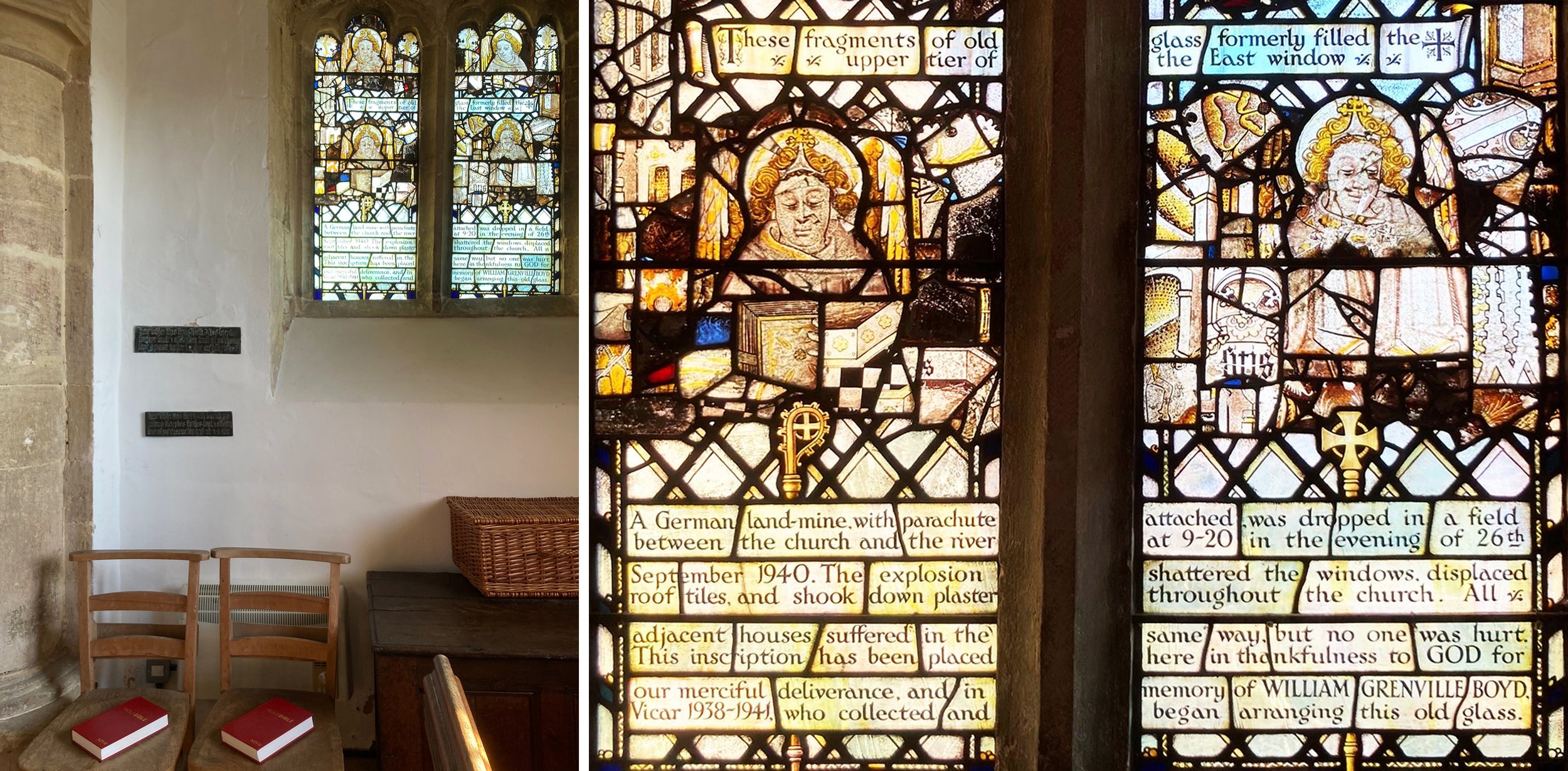On holiday in the South Hams district of Devon we visited five churches, chosen just because they were on our route. All are large rural churches with rows of massive pillars down the nave and, a Devon speciality, a fine medieval rood screen separating the nave from the chancel. The photos I took in the five churches looking down the nave to the screen and the east window beyond show the similarities, but each screen is different and each church has its own particular atmosphere.
Church of St Sylvester, Chivelstone: exterior, nave, fragmented screen end.
A series of new panels describes the history of the large church in the tiny village of Chivelstone, formerly the main place of worship for agricultural workers from all the villages to the south, between Chivelstone and the sea. These are part of an on going programme of repair that includes the conservation of the medieval screen and pulpit and later wall paintings (C17th - 18th). The rood screen has fifteenth and sixteenth century sections, with some painted figures, some renaissance arabesque panels and some reassembled fragments (above right). This is a harmonious interior with little touches of colour, like the pink around the borders of windows and the welcome stained glass of the decorative Victorian variety in the chancel (below centre and right).
St Sylvester, Chivelstone: back of screen, pink bordered window, stained glass in chancel.
Church of St Winwaloe, East Portlemouth: nave, screen, detail of medieval painting on screen.
In the church at East Portlemouth, two and a half miles to the west, the only stained glass is in a drawing hanging on the wall (below left) by the architect Sir Charles Nicholson who carried out the 1934 restoration of the church. Here the panels on the rood screen are filled with 26 exceptional early sixteenth century paintings of saints, beautiful and delicate, like the carving that surrounds them (above right). But the large windows with criss crossed lead lines and lime green borders give this church a chilly atmosphere (below right).
St Winwaloe, East Portlemouth: drawing by Charles Nicholson, reredos as seen in drawing, window with teddy.
Church of St Nicholas and St Cyriac, South Pool: nave, screen, detail of painting on screen.
Next was South Pool, a couple of miles north east along the river estuary. The rood screen in this church is covered in the now familiar carvings of vines and scrolls and painted in mainly reds and greens. The lower panels are all painted in the rare renaissance arabesque style (above right), behind them you can see subtle stained glass in the east window. I was looking forward to finding some more modern stained glass in one of these interiors, here we get a cheesy scene of the village by Roy Coomber of Solaglas, Bristol 1988 (below left) and a number of saints from the Exeter firm of David Gubbin and Son. You can always find a nice bit of detail in this type of glass, like the birds flying in front of St Francis (below right), but do they add anything to the quality of the interior space? - particularly when the scenes and figures are laid on those clear backgrounds that do nothing to temper the light.
St Nicholas and St Cyriac, South Pool: stained glass from the 1980s and 1990s.
Church of St Andrew, Harberton: nave, screen, screen pillar.
Simon Jenkins, in England’s Thousand Best Churches, would say no, but then he doesn’t seem to be very keen on stained glass. To me it was wonderful to go into our next church at Harberton and find all the windows filled with colour - and also to find explanatory boards complete with names and dates (all the windows were made between 1854 and 1931) - but to Simon Jenkins the stained glass in this church is ‘ubiquitous and pernicious’. The whole interior shines, the heavily restored rood screen is detailed in gold with figures of saints that were painted on metal panels in 1871 to replace the original wooden ones, now displayed on the wall of the nave in this very informative and rich interior.
St Andrew, Harberton: screen sideview, The Trist window to the four virgin martyrs Saints Catherine, Agnes, Margaret & Barbara by Beer of Exeter, detail from 1931 window by Maile & Sons.
Church of St Mary, Berry Pomeroy: nave, screen sideview, screen detail.
Berry Pomeroy Church, in the north of the district, rounded off our trip with another magnificent rood screen going from wall to wall in the nave. This one has all its original parts and its painted figures, though they were defaced during the Civil War or the Restoration (above right). The side views of the screens in the last two churches show how far the cornice overhangs, and also the clutter of furniture in front of them (above middle) which I only then realised was to protect the paintings from being bashed. High up in the chancel are three windows by the great Christopher Whall, and there is another by his daughter Veronica in the north east chapel (below right). By this stage I had started to make comparisons and couldn’t help thinking that Christopher Whall’s chancel windows are in the wrong place. They are too elevated to have much chance of interacting with the shapes and colours in the screen, although they were the only windows we saw that could stand up to the comparison.
St Mary, Berry Pomeroy: stained glass in the chancel by Christopher Whall 1908 and by Veronica Whall 1926























